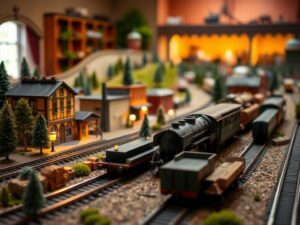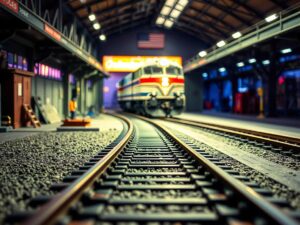Budgeting for Your First HO Scale Layout
Budgeting for Your First HO Scale Layout
Budgeting for Your First HO Scale Layout: Launching Your Model Railroad Dream
Welcome aboard, aspiring railroad enthusiasts! The world of model trains is an incredibly rewarding hobby that offers endless opportunities for creativity, learning, and sheer fun. But like any passionate pursuit, getting started can sometimes feel daunting â especially when you’re looking at the seemingly astronomical cost of building your own HO scale layout. Donât worry, fellow train lovers! This guide is here to break down the often-overlooked financial side of things and show you exactly how to budget for your first HO scale layout without breaking the bank.
Understanding the “Cost Factor”
The initial sticker shock when delving into model railroading can be real.
But here’s the good news: There’s no single answer to âhow much does an HO scale layout cost?”. Itâs truly as personal as your own train dream. Think of it like planning a dream vacation â some trips are quick getaways, others involve elaborate expeditions with many moving parts. The beauty of model railroading is that you can choose your level of complexity and scale accordingly.
Essential vs. âNice to Haveâ: Distinguishing Your Needs
To get started with your budget HO scale layout, itâs crucial to prioritize what’s absolutely essential versus those “luxury” additions. Let’s break down the categories:
- The Heart of It All â Locomotives and Rolling Stock: These are your showpieces, pulling those majestic freight cars or elegantly streamlined passenger coaches. Start small with a single locomotive that suits your envisioned theme (a vintage steam engine for a nostalgic scene, a modern diesel for industrial realism, etc.) and a couple of cars to go with it. You can expand this fleet as your budget allows. Remember: Starter sets are often a great way to acquire basic equipment at an attractive price point!
- Track â The Rails that Bind It All:
Start with enough track to create a simple oval or a small loop. Don’t overbuy initially â you can always expand later as your layout evolves.
Track options abound, from beginner-friendly pre-packaged starter sets to modular layouts for greater flexibility and customizability. Remember: The track needs to match the scale of your models (HO in our case), and there are different types of track depending on how realistic you want it to look â basic flexible track versus more intricate “flex” track, and then thereâs scenic curved tracks that really bring the beauty of rolling hills to life.
-
Power Supply & Command System: This powers everything! For simple layouts, a straightforward power supply unit is usually sufficient. But if you envision advanced operations (different speed controls, realistic sound effects, etc.), consider investing in a command control system later down the line. These can be a more complex addition but open up amazing possibilities for detailed simulations of train traffic and schedules.
-
Basic Scenery Essentials: You don’t need to build Mount Everest right away! Start with basic terrain features (elevation changes, gentle curves). Some textured fabric, sand, small rocks, and even houseplants can help establish your initial setting. Add details as you progress â trees, bushes, buildings. This is where your creativity really shines through!
Stretching Your Budget – Saving Without Sacrificing Satisfaction:
-
Used Gear is Gold: The beauty of model railroading is its long lifespan. There’s a thriving secondhand market for locomotives, rolling stock, and even layouts themselves! Online marketplaces (think eBay, Facebook Marketplace) or your local train club can offer incredible deals on pre-owned items in excellent condition. Remember, these âsecond lifeâ pieces often carry with them stories of their own â adding to the unique character of your layout.
-
Build Gradually: Resist the urge to rush into a massive project! Start small and focus on creating one cohesive section at a time. Expand as your skills grow and your budget allows. Think of it like laying down bricks for a castle â each step strengthens your overall vision.
-
Resourcefulness is Key: Use everyday materials creatively! Cardboard boxes can become structures, empty soda bottles morph into bridges, even bottle caps can be painted to look like realistic track fasteners. Donât underestimate the power of improvisation â youâd be surprised at how much a little ingenuity can achieve!
-
Set Clear Spending Limits: Create a budget spreadsheet (even a simple one!) and stick to it. Track your expenses for each item. Remember: You can always adjust your layout plan based on your available funds. Prioritize what matters most, then celebrate your progress along the way!
-
Find Your Community:
Connecting with other model railroad enthusiasts is invaluable â whether through online forums, local train clubs, or even sharing tips and stories with friends who share your passion. Thereâs a wealth of knowledge out there to tap into!
Essential Tools For Success â Beyond Just Trains
To truly get the most out of your hobby, equip yourself with some essential tools that make your life easier and elevate your building skills:
- Hobby Knife: An indispensable tool for cutting track, scenery materials, and assembling kits.
Sharp blades are key for clean cuts!
- Small Screwdrivers: These come in handy for attaching components, tightening screws on locomotives and rolling stock, and working with miniature details.
Precision matters here â consider getting a set with different sizes and types of tips.
* Glue: A variety of glues are used in model railroading â plastic cement (CA glue) for joining styrene plastic, PVA wood glue for structures, superglue for tiny tasks. Choose what suits your needs!
-
Measuring Tape & Ruler: Accuracy is key! Measuring tape and ruler will ensure your track alignment, structure placement, and scenery elements are precisely where you want them to be.
-
Tweezers: Essential for handling small parts and placing them with precision. Look for those with fine tips and a good grip.
Building Your Dream: A Journey, Not a Race!
Remember, this is YOUR layout â designed by YOU and built at your own pace. Enjoy the process of planning, gathering resources, and bringing your vision to life!
Donât forget to celebrate milestones:
Completing a section of track, painting a building, even adding a few strategically placed trees – each accomplishment adds to the magic of model railroading. Share your journey with other enthusiasts â learn from them, inspire them, and most importantly, have fun creating your own piece of the world, one miniature masterpiece at a time!
Let’s Hear From You:
What aspects of building a budget HO scale layout are most important to you? Do you have any tips for fellow beginners who want to get started without breaking the bank? Share your thoughts and experiences in the comments below â let’s build this community together, track by track!




